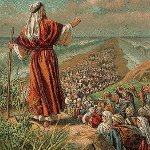Passover (Pesach) Date in the current year: April 12, 2025
 Passover, also known as Pesach, is one of the most significant Jewish holidays. It commemorates the liberation of the Jewish people from slavery in ancient Egypt and the story of the Exodus. This festival commences on the 15th day of Nisan in the Hebrew calendar and lasts for seven days in Israel and for eight days in the diaspora.
Passover, also known as Pesach, is one of the most significant Jewish holidays. It commemorates the liberation of the Jewish people from slavery in ancient Egypt and the story of the Exodus. This festival commences on the 15th day of Nisan in the Hebrew calendar and lasts for seven days in Israel and for eight days in the diaspora.Passover is a spring festival which typically begins on the first or sometimes the second full moon after the vernal equinox in the Northern Hemisphere. It is one of the so-called Shalosh Regalim, the three biblically derived Jewish festivals that required pilgrimage to the Holy Temple, the other two being Shavuot and Sukkot.
The name of the holiday in the English language is derived from the words “pass over”, referring to the salvation of Jewish babies from the tenth plague of Egypt. When the angel of death killed the Egyptian first-born, he passed over Jewish homes because they had been marked with lamb’s blood.
Another name for the holiday is the feast of unleavened bread (Chag Ha-Matzot). It was inspired by another episode of the Exodus. When the Israelites were freed by the Pharaoh, they left in such a hurry that bread dough had no time to leaven. In commemoration, Jews are forbidden to eat or even own leavened foods for the whole duration of Passover. Instead, they eat flat unleavened brand called matzo, matzah, or matza. It is made with only two ingredients, flour and water.
The Hebrew term for leavened foods is chametz. The term refers to products that are both made from one of five varieties of grain and have been in contact with water for longer than eighteen minutes. This includes bread, cookies, cakes, pasta, pizza, certain types of alcohol made of fermented grain (beer, whiskey, vodka), and other products.
Jews start preparing for Pesach long before the holiday commences as they need to remove all chametz from their homes. In many Jewish households, cleaning for Passover is associated with spring cleaning; although the primary goal of Passover cleaning is to remove all chametz from one’s house, not to make it squeaky clean. If chametz is too expensive to be discarded, it can be symbolically sold to a non-Jew and repurchased after the holiday.
Probably the most important tradition of Pesah is the Passover seder. It is a ritual dinner held on the first night of the holiday. The order of the Seder is set forth by the Hagaddah, a Jewish text that narrates the story of the Jewish liberation from slavery in Ancient Egypt under the leadership of Moses and the Exodus. It divides the meal into 15 parts, mirroring the 15 steps in the Holy Temple in Jerusalem.
On the seder table, there is a special plate (ke’ara) containing six symbolic foods: maror and chazeret (two kinds of bitter herbs), charoset (a paste of fruit, nuts, and wine or juice), karpas (a vegetable), zeroa (a roasted lamb bone), and beitzah (a hard-boiled egg). It is also required to drink at least four cups of kosher wine and eat matzo at certain points of the meal.
A special role in the Passover seder is given to children. Traditionally, the youngest child in the family asks the so-called four questions, wondering why the night of the seder is different from all other nights. In response, the leader of the seder begins to recount the story of the Exodus. In addition, children hide the afikoman (a piece of matzo set aside to be consumed during the 12th part of the meal) and demand a reward for its return.
- Category
- Religious Holidays
- Country
- Israel
- Tags
- Pesach, Passover, Jewish holidays, religious holidays, Exodus, Seder, Hagaddah